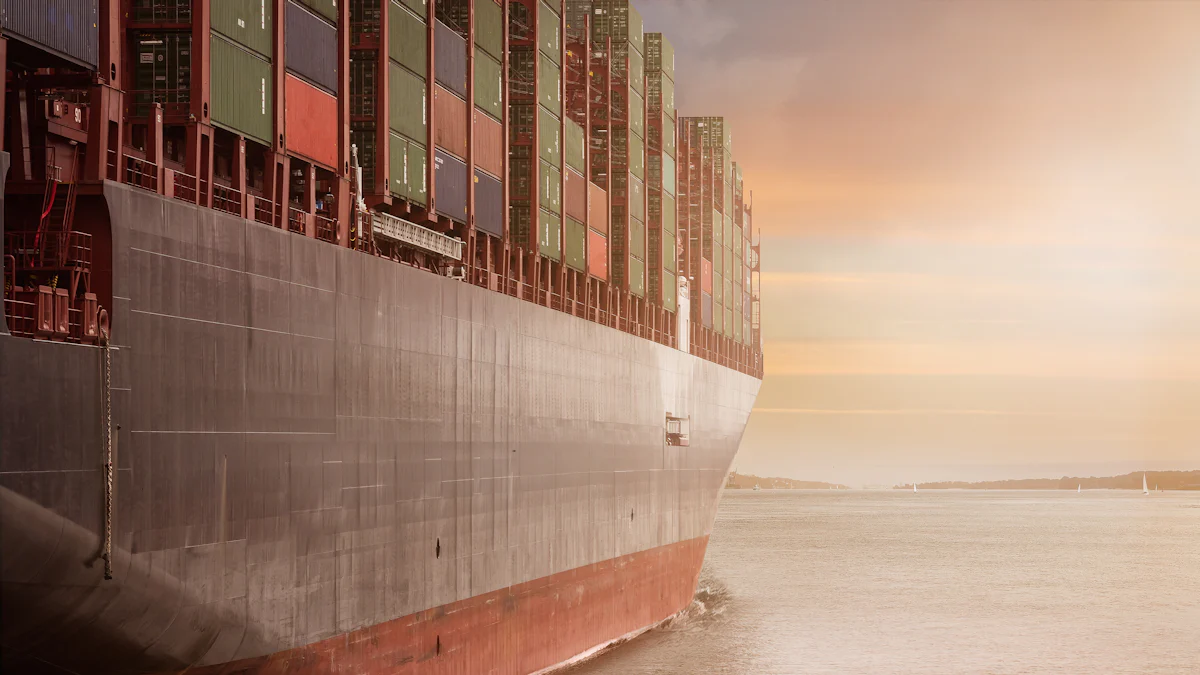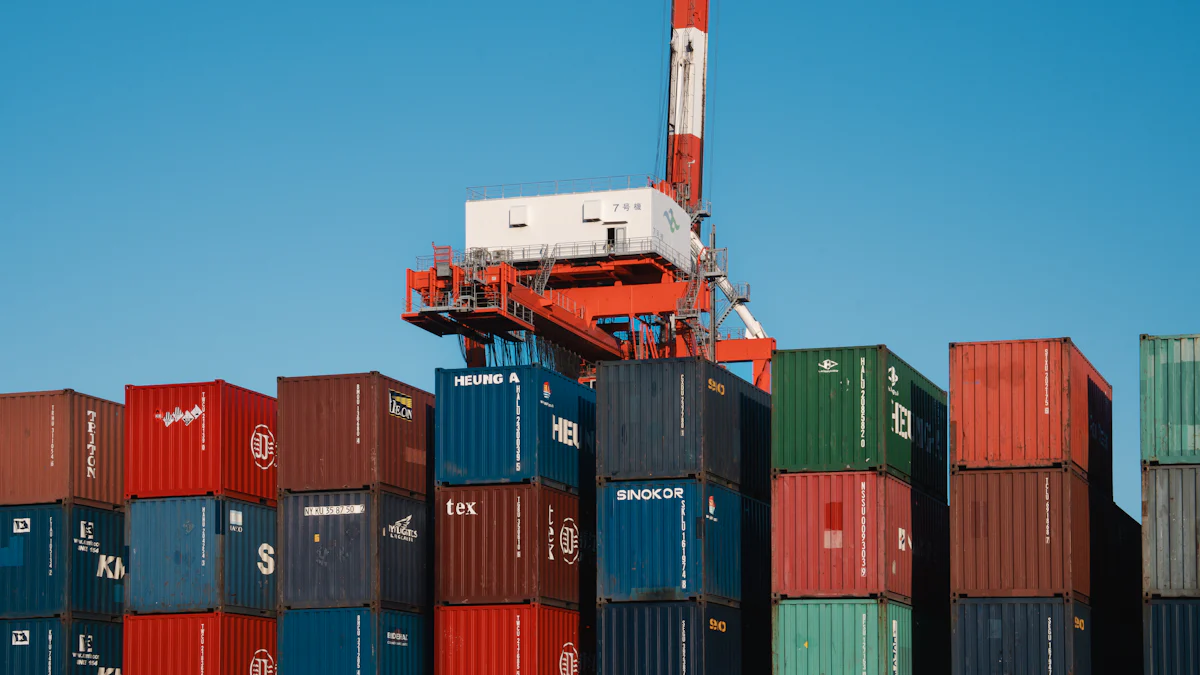Why Global Events Shape Supply Chain Risks in 2025

Global supply chains in 2025 face unprecedented challenges due to external disruptions. Trade changes, including potential tariffs and retaliatory measures, continue to reshape global commerce. Labor strikes, which surged by 280% year-over-year in 2023, disrupt operations across industries. Geopolitical conflicts restrict airspace and shipping routes, while climate change forces businesses to reconsider supply chain strategies. Additionally, shifts in consumer demand alter shipping practices, further complicating logistics. These factors amplify supply chain risks, requiring businesses to adapt swiftly to maintain resilience and continuity in an increasingly volatile environment.
Key Global Events Driving Supply Chain Risks in 2025

Geopolitical Tensions
Trade restrictions and sanctions
Trade restrictions and sanctions continue to create significant challenges for global supply chains. Historically, these measures have disrupted the flow of goods, forcing businesses to adapt quickly. For example, sanctions on North Korea targeted forced labor practices, impacting supply chain operations. Similarly, the sanctions following Russia's invasion of Ukraine reshaped global supply chain dynamics, particularly in energy and raw materials. These actions often lead to cascading effects, requiring supply chain managers to reassess sourcing strategies and mitigate risks.
Regional conflicts disrupting supply routes
Regional conflicts further exacerbate supply chain disruptions. The ongoing Russia-Ukraine war has disrupted global supply chains for over 700 days, affecting oil, natural gas, and agricultural exports. The Israel-Hamas war has strained Israeli ports, suspended operations, and increased shipping costs. These conflicts highlight the physical risks associated with geopolitical instability, as supply routes become unreliable and transportation costs surge.
Geopolitical Tension | Impact on Supply Chains |
|---|---|
Israel-Hamas War | Strained ports in Israel, suspended operations, increased shipping costs, potential gas market squeeze. |
Russia-Ukraine War | Sanctions affecting oil and natural gas, ongoing conflict disrupting global supply chains for over 700 days. |
Climate Change Risks
Extreme weather events impacting production and transportation
Extreme weather events pose significant climate change risks to supply chains. Hurricanes, floods, and wildfires disrupt production and transportation, leading to longer delivery times and higher costs. Hurricane Ian, for instance, caused a 75% drop in shipments and increased shipping times by 2.5 days. Weather-related issues account for 23% of all road delays in the U.S., costing trucking companies billions annually. These disruptions emphasize the need for businesses to develop climate-resilient strategies.
Resource scarcity and its effect on raw material availability
Climate-related regulations and environmental changes contribute to resource scarcity, affecting raw material availability. Over 99% of surveyed executives reported that climate change impacts their supply chains, with disruptions affecting both upstream and downstream operations. The economic risks of climate change to global trade are estimated at $81 billion, potentially rising to $122 billion. Supply chain managers must address these challenges by diversifying sourcing and adopting sustainable practices.
Economic Instability
Currency fluctuations and inflation
Currency fluctuations and inflation significantly impact supply chain operations, creating financial and logistical challenges for businesses. Fluctuating exchange rates often increase the cost of essential inputs, such as energy, which directly affects production expenses. For instance, during the Asian financial crisis of the late 1990s, currency sell-offs delayed construction projects and reduced industrial energy demand. These disruptions forced companies to reevaluate their supply chain planning to mitigate risks.
Inflation further compounds these challenges by driving up production and transportation costs. Recent events, including China's factory shutdowns and the war in Ukraine, have disrupted global supply chains, leading to inflation in commodity prices. The US Producer Price Index, a key indicator of inflation, rose sharply due to these disruptions, complicating procurement processes and increasing costs for consumers. Supply chain managers must adopt proactive strategies to navigate these financial pressures, such as diversifying suppliers and optimizing transportation routes.
Shifts in consumer demand and spending patterns
Economic instability also triggers shifts in consumer demand and spending patterns, creating additional risks for supply chains. During periods of uncertainty, consumers often prioritize essential goods over discretionary items, leading to sudden changes in demand. These shifts can disrupt inventory management and strain supply chain networks, particularly for businesses unprepared to adapt quickly.
Strategic supply chain location decisions play a critical role in addressing these challenges. By positioning distribution centers closer to key markets, businesses can respond more effectively to changing consumer preferences. Additionally, leveraging data analytics enables companies to forecast demand fluctuations and adjust their operations accordingly. As economic conditions evolve, businesses must remain agile to maintain resilience and meet consumer expectations.
Challenges Businesses Face in Managing Supply Chain Risks
Lack of Real-Time Data
Delayed decision-making due to outdated information
Businesses often struggle with delayed decision-making caused by outdated information. Integrating data from diverse sources presents standardization challenges, while legacy systems with outdated technology hinder seamless integration. Network latency further complicates real-time processing, especially during peak periods when data volumes surge. These delays prevent supply chain managers from responding promptly to disruptions, increasing operational risks. Cybersecurity incidents also highlight the need for stringent security measures, as breaches can compromise sensitive supply chain data.
Limited visibility across supply chain networks
Limited visibility across supply chain networks remains a critical issue. Without comprehensive insights, businesses face difficulties in tracking quality issues, managing inventory, and identifying root causes of disruptions. Technologies like supply chain visibility software and artificial intelligence can address these challenges by gathering reliable data and analyzing it efficiently. Improved communication with suppliers also enhances transparency, enabling quicker responses to risks and better strategic planning.
Limited Predictive Capabilities
Difficulty in forecasting disruptions
Forecasting disruptions remains a significant challenge for businesses. Sudden events, such as extreme weather or geopolitical instability, often catch supply chain managers off guard. Without advanced predictive tools, businesses struggle to anticipate these risks, leading to costly delays and inefficiencies.
Inability to prepare for sudden changes in demand or supply
The inability to prepare for sudden changes in demand or supply further complicates supply chain management. For instance, shifts in consumer behavior during economic instability can create unexpected demand spikes. Businesses lacking predictive analytics face difficulties in adjusting their operations, resulting in inventory shortages or surpluses.
Overreliance on Single Suppliers or Regions
Increased vulnerability to localized disruptions
Overreliance on single suppliers or regions exposes businesses to significant risks. For example, Apple's dependency on Foxconn caused shipment delays during COVID-19 restrictions. Geographic concentration risk also became evident during the pandemic, as many companies relying on Chinese suppliers faced widespread supply chain disruptions.
Challenges in diversifying supply sources
Diversifying supply sources presents its own set of challenges. Identifying risks and vulnerabilities requires thorough analysis, while sourcing from multiple regions demands careful planning. Developing redundancy through backup suppliers and contingency plans can mitigate these risks, but implementing these strategies often involves significant investment and effort.
Rising Costs and Resource Constraints
Higher costs of transportation and raw materials
Rising transportation and raw material costs continue to challenge supply chain operations. Transportation expenses have surged due to increased fuel prices, labor shortages, and higher demand for logistics services. These factors strain budgets and force businesses to reevaluate their shipping strategies. Additionally, procurement costs have risen as geopolitical tensions and climate-related disruptions limit access to essential resources. For example, extreme weather events have damaged infrastructure, delaying shipments and increasing freight rates.
Raw material costs have also escalated due to resource scarcity and stricter environmental regulations. Industries reliant on metals, agricultural products, and energy face significant price volatility. Supply chain managers must navigate these challenges by optimizing routes, consolidating shipments, and negotiating long-term contracts with suppliers. These strategies help mitigate risks while maintaining operational efficiency.
Innovative Solutions to Enhance Supply Chain Resilience

Leveraging AI and Machine Learning
Predictive analytics for identifying potential risks
Artificial intelligence (AI) and machine learning (ML) are transforming predictive analytics in supply chain management. These technologies analyze vast datasets to identify patterns and correlations that traditional methods often miss. Businesses can use AI-powered tools to forecast potential risks, such as supply shortages or transportation delays, and implement risk mitigation measures proactively. For example, Walmart employs AI to optimize inventory and address inefficiencies, while Western Digital uses predictive engines to safeguard its supply chain during crises. These advancements enhance resilience by enabling companies to anticipate disruptions and minimize financial losses.
Automated decision-making to respond to disruptions
AI-driven decision-support systems process real-time data to recommend optimal actions during disruptions. These systems consider supply-and-demand dynamics, company priorities, and external factors to suggest solutions like adjusting production levels or rerouting shipments. For instance, AI-based supplier management tools audit supplier networks and identify vulnerabilities, ensuring businesses remain agile. By automating decision-making, companies can respond swiftly to physical risks, reducing the impact of disasters on operations.
Digitalization and Real-Time Data Streaming
Enhanced visibility through IoT and connected devices
Digitalization, powered by IoT and connected devices, provides unparalleled visibility into supply chain operations. Companies like Maersk track containers in real time, improving logistics efficiency and reducing costs. Walmart uses IoT to monitor storage conditions for fresh produce, ensuring quality and minimizing losses. These technologies enable businesses to conduct thorough risk assessments and adapt to future climate risks effectively.
Faster response times with real-time updates
Real-time data streaming accelerates decision-making by providing instant updates on supply chain activities. This capability allows businesses to address disruptions promptly, reducing downtime and financial losses. For example, Amazon’s investment in warehouse robotics enhances operational speed and accuracy. By integrating real-time data, companies can implement solutions that improve efficiency and resilience.
Adoption of Digital Twins
Simulating supply chain scenarios to test resilience
Digital twins simulate real-world supply chains, allowing businesses to test various scenarios and evaluate their resilience. These virtual models help companies anticipate disruptions, optimize operations, and prepare for emergencies. For instance, DHL uses digital twins to simulate delivery routes, reducing delays and fuel consumption. This approach strengthens supply chain resilience by identifying inefficiencies before they escalate.
Identifying vulnerabilities before they occur
Digital twins provide a comprehensive view of supply chain operations, enabling businesses to pinpoint vulnerabilities. Walmart leverages this technology to optimize inventory management and store layouts, enhancing customer satisfaction. By identifying risks early, companies can implement targeted risk mitigation measures, ensuring continuity during disruptions.
Distributed and Decentralized Systems
Reducing reliance on single points of failure
Distributed and decentralized systems reduce supply chain risks by minimizing reliance on single points of failure. These systems distribute operations, ensuring that disruptions in one area do not halt the entire supply chain. For instance, decentralizing production facilities across regions allows businesses to continue operations even when localized disruptions occur. This approach enhances flexibility and agility, enabling companies to address issues at a local level without affecting global operations.
The benefits of decentralization extend beyond operational continuity. Empowering individual sites to solve problems fosters creative problem-solving and builds resilience through cross-functional collaboration. The table below highlights key advantages of distributed systems:
Benefit | Description |
|---|---|
Flexibility and Agility | Decentralized systems enable flexibility and agility for localized issues. |
Creative Problem-Solving | A decentralized supply chain can empower individual sites to solve problems creatively. |
Resilience | Decentralizing supply chains builds resilience through cross-functional collaboration and action. |
Building redundancy into supply chain networks
Building redundancy into supply chain networks strengthens resilience and mitigates risks associated with disruptions. Companies achieve this by implementing strategies that ensure alternative options are available during crises. Examples include:
Diversifying suppliers across multiple locations to reduce dependency on a single source.
Utilizing multi-sourcing to procure the same materials from different suppliers.
Maintaining inventory buffers for critical components to sustain operations during supply interruptions.
Establishing alternative transportation routes and carriers to avoid reliance on a single method.
Partnering with dual suppliers for the same component, designating one as primary and the other as backup.
Decentralizing manufacturing facilities across regions to minimize the impact of localized disruptions.
Collaborating with suppliers to identify vulnerabilities and implement risk mitigation strategies.
Leveraging advanced technologies like AI and IoT to enhance visibility and efficiency.
Forming strategic partnerships to share resources and expertise for better crisis response.
Continuously monitoring supply chains and conducting scenario planning to proactively address potential disruptions.
These measures ensure that businesses can adapt to challenges, whether caused by geopolitical tensions, climate-related events, or economic instability. By integrating redundancy and decentralization, companies can safeguard their supply chains and maintain operational continuity.
Actionable Strategies for Businesses to Adapt in 2025
Invest in Scalable and Flexible Systems
Building infrastructure that can adapt to changing demands
Businesses must prioritize scalable systems to address the dynamic nature of supply chain risks. These systems allow companies to adjust operations based on fluctuating demand or unexpected disruptions. Key features include customization, which enables tailored solutions like modifying delivery routes or shipping options, and agility, which ensures rapid responses to challenges. For instance, integrating automation and IoT enhances logistics flexibility, allowing businesses to maintain seamless operations during crises.
Scalable systems also offer significant benefits. They reduce fixed costs by optimizing resource utilization and improve customer satisfaction through faster delivery and real-time tracking. Moreover, they support business growth by accommodating new markets and products without compromising efficiency. Companies investing in such infrastructure position themselves to adapt effectively to evolving supply chain challenges.
Prioritizing modular and agile supply chain designs
Modular supply chain designs enhance adaptability by breaking operations into smaller, independent units. This approach allows businesses to reconfigure processes quickly in response to disruptions. Agile designs further strengthen resilience by enabling rapid adjustments to production schedules or inventory levels. Together, these strategies ensure supply chains remain robust in the face of climate-related risks or geopolitical tensions.
Leverage Predictive Analytics and Scenario Planning
Using data to anticipate and mitigate risks
Predictive analytics empowers businesses to foresee potential disruptions and take preemptive action. By analyzing historical and real-time data, companies can improve demand forecasting, streamline inventory management, and optimize transportation planning. For example, supply chain managers can use predictive tools to anticipate risks like stockouts or overstock, reducing costs and enhancing customer satisfaction.
Preparing contingency plans for various disruption scenarios
Scenario planning complements predictive analytics by preparing businesses for diverse challenges. Companies can develop contingency plans by assessing risks, identifying triggers, and outlining response strategies. A food distribution company, for instance, might monitor geopolitical unrest to secure alternative suppliers and ingredients. Similarly, network providers often create recovery objectives to address outages caused by security breaches. These proactive measures ensure operational continuity during crises.
Diversify Suppliers and Regional Operations
Reducing dependency on single suppliers or regions
Overreliance on a single supplier or region increases vulnerability to localized disruptions. Diversifying suppliers mitigates this risk by ensuring alternative sources are available. For example, businesses can adopt multi-sourcing strategies to procure materials from different regions, reducing exposure to climate-related risks or geopolitical instability.
Expanding operations to mitigate localized risks
Strategic supply chain location decisions play a critical role in minimizing risks. By expanding operations across multiple regions, companies can reduce the impact of localized disruptions. This approach not only enhances resilience but also improves access to key markets, enabling businesses to respond more effectively to shifts in consumer demand.
Adopt Sustainable Practices
Reducing environmental impact to align with global trends
Businesses in 2025 face increasing pressure to adopt environmentally conscious strategies. Governments, consumers, and investors demand accountability for carbon emissions, waste management, and resource usage. Companies that fail to address these concerns risk reputational damage and regulatory penalties.
Reducing environmental impact requires a multi-faceted approach. Many organizations are transitioning to renewable energy sources to power their operations. For example, manufacturers are installing solar panels and wind turbines to reduce reliance on fossil fuels. Logistics companies are adopting electric vehicles and optimizing delivery routes to cut emissions. Additionally, businesses are implementing circular economy models, which focus on reusing materials and minimizing waste.
Sustainability certifications, such as ISO 14001, also play a critical role. These certifications demonstrate a company’s commitment to environmental stewardship, enhancing its credibility in the global market. By aligning with global trends, businesses not only reduce their ecological footprint but also gain a competitive edge.
Building long-term resilience through sustainable sourcing
Sustainable sourcing strengthens supply chain resilience by ensuring long-term access to critical resources. Companies that prioritize ethical and environmentally friendly practices reduce their exposure to risks such as resource scarcity and regulatory changes. For instance, sourcing raw materials from certified suppliers ensures compliance with environmental standards and mitigates supply disruptions.
Collaboration with local suppliers further enhances resilience. Local sourcing reduces transportation costs and emissions while supporting regional economies. Businesses can also invest in regenerative agriculture and sustainable forestry to secure raw materials for the future. These practices promote biodiversity and soil health, ensuring resource availability for generations to come.
Adopting sustainable practices enables companies to build robust supply chains that withstand global challenges. By integrating sustainability into their operations, businesses can achieve long-term growth while contributing to a healthier planet.
Global events in 2025 will continue to redefine supply chain risks, demanding businesses to adopt proactive strategies. Understanding the drivers of risk, such as geopolitical tensions and climate change, equips companies to address vulnerabilities effectively.
Key Takeaway: Resilience stems from innovation and adaptability.
Investing in scalable systems, predictive analytics, and sustainable practices ensures operational continuity. Companies that embrace these solutions position themselves to thrive in volatile environments. By prioritizing flexibility and foresight, businesses can transform challenges into opportunities, securing long-term success in an unpredictable global landscape.
See Also
Don't Overlook Supply Chain Threats: Safeguard Your Company Now
Explore 5 Essential Supply Chain Conferences You Can't Miss
Enhancing Supply Chain Performance: 5 Key Emerging Trends
